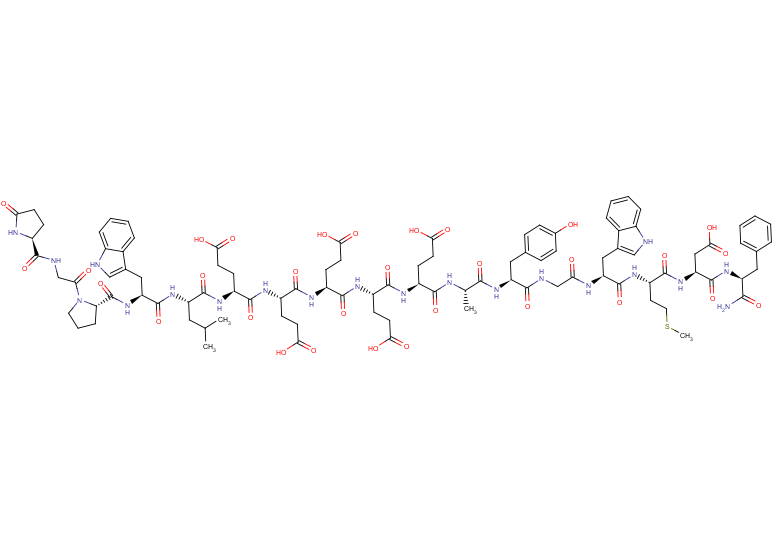Gastrin I, human
| Code | Size | Price |
|---|
| TAR-TP2030-1mg | 1mg | £158.00 | |||||||||||||||||||||||||||||||||||||||||||||||||||||||||||||||||||||||||||||||||||||||||||||||||
| Special offer! Add £1 to your order to get a TargetMol CCK-8 Kit. Read more here. | |||||||||||||||||||||||||||||||||||||||||||||||||||||||||||||||||||||||||||||||||||||||||||||||||||
Quantity:
| TAR-TP2030-5mg | 5mg | £412.00 | |||||||||||||||||||||||||||||||||||||||||||||||||||||||||||||||||||||||||||||||||||||||||||||||||
| Special offer! Add £1 to your order to get a TargetMol CCK-8 Kit. Read more here. | |||||||||||||||||||||||||||||||||||||||||||||||||||||||||||||||||||||||||||||||||||||||||||||||||||
Quantity:
| TAR-TP2030-10mg | 10mg | £607.00 | |||||||||||||||||||||||||||||||||||||||||||||||||||||||||||||||||||||||||||||||||||||||||||||||||
| Special offer! Add £1 to your order to get a TargetMol CCK-8 Kit. Read more here. | |||||||||||||||||||||||||||||||||||||||||||||||||||||||||||||||||||||||||||||||||||||||||||||||||||
Quantity:
| TAR-TP2030-25mg | 25mg | £978.00 | |||||||||||||||||||||||||||||||||||||||||||||||||||||||||||||||||||||||||||||||||||||||||||||||||
| Special offer! Add £1 to your order to get a TargetMol CCK-8 Kit. Read more here. | |||||||||||||||||||||||||||||||||||||||||||||||||||||||||||||||||||||||||||||||||||||||||||||||||||
Quantity:
| TAR-TP2030-50mg | 50mg | £1,291.00 | |||||||||||||||||||||||||||||||||||||||||||||||||||||||||||||||||||||||||||||||||||||||||||||||||
| Special offer! Add £1 to your order to get a TargetMol CCK-8 Kit. Read more here. | |||||||||||||||||||||||||||||||||||||||||||||||||||||||||||||||||||||||||||||||||||||||||||||||||||
Quantity:
| TAR-TP2030-100mg | 100mg | £1,661.00 | |||||||||||||||||||||||||||||||||||||||||||||||||||||||||||||||||||||||||||||||||||||||||||||||||
| Special offer! Add £1 to your order to get a TargetMol CCK-8 Kit. Read more here. | |||||||||||||||||||||||||||||||||||||||||||||||||||||||||||||||||||||||||||||||||||||||||||||||||||
Quantity:
Prices exclude any Taxes / VAT
Overview
Regulatory Status: RUO
Shipping:
cool pack
Storage:
-20℃
Images
Documents
Further Information
Bioactivity:
Endogenous peptide produced in the stomach that acts as a selective CCK2 receptor agonist. Stimulates gastric acid secretion. Also used in the culture of stomach organoids.
Biological Applications:
In the culture process of gastrointestinal organs, gastrin I can promote gastric acid secretion, proliferation, and repair of gastric mucosal cells. It also simulates the physiological environment in the body, helping to maintain the normal development and function of gastric organs. Therefore, in the culture process of gastrointestinal organs, gastrin I is often added as an auxiliary factor to the culture medium.
CAS:
10047-33-3
Formula:
C97H124N20O31S
Long Description:
Gastrin I, human, also known as Gastrin I (human) or Gastrin 1, is an endogenous peptide produced in the stomach. It increases gastric pepsinogen and gastric acid secretion in rats through the CCK2 receptor.
Mechanism of Action:
Gastrin is an important gastrointestinal hormone mainly secreted by G cells. G cells are typical open-type cells, most abundant in the gastric antrum, followed by the gastric fundus, duodenum, and jejunum. Gastrin I is one of the earliest discovered subtypes of gastrin. Gastrin affects almost the entire gastrointestinal tract. It can promote the synthesis of DNA, RNA, and proteins in the mucosa of the gastric acid gland area and duodenal mucosa, thereby promoting mucosal cell growth and proliferation. The main functions of gastrin include: 1. Stimulating the synthesis of DNA, RNA, and proteins in the mucosa of the gastric acid gland area and duodenal mucosa, thereby promoting mucosal cell growth and proliferation. 2. Stimulating parietal cells to secrete hydrochloric acid and chief cells to secrete pepsinogen. 3. Stimulating gastric antrum and intestinal movement, delaying gastric emptying. 4. Stimulating the secretion of pancreatic juice, bile, and intestinal juice.
Molecular Weight:
2098.23
Pathway:
GPCR/G Protein
Purity:
0.98
Research Area:
Organiod (gastrointestinal, liver, pancreas)
SMILES:
CSCC[C@H](NC(=O)[C@H](Cc1c[nH]c2ccccc12)NC(=O)CNC(=O)[C@H](Cc1ccc(O)cc1)NC(=O)[C@H](C)NC(=O)[C@H](CCC(O)=O)NC(=O)[C@H](CCC(O)=O)NC(=O)[C@H](CCC(O)=O)NC(=O)[C@H](CCC(O)=O)NC(=O)[C@H](CCC(O)=O)NC(=O)[C@H](CC(C)C)NC(=O)[C@H](Cc1c[nH]c2ccccc12)NC(=O)[C@@H]1CCCN1C(=O)CNC(=O)[C@@H]1CCC(=O)N1)C(=O)N[C@@H](CC(O)=O)C(=O)N[C@@H](Cc1ccccc1)C(N)=O
Target:
cholecystokinin
References
Blandizzi C, et al. CCK1 and CCK2 receptors regulate gastric pepsinogen secretion. Eur J Pharmacol. 1999 May 28;373(1):71-84.
Noble F, et al. International Union of Pharmacology. XXI. Structure, distribution, and functions of cholecystokinin receptors. Pharmacol Rev. 1999 Dec;51(4):745-81.
Mahe et al (2014) Establishment of gastrointestinal epithelial organoids Curr.Protoc. Mouse Biol. 3 217 PMID:
Sato et al (2015) SnapShot: Growing Organoids from Stem Cells. Cell 161 1700 PMID:
Bartfeld et al (2015) In vitro expansion of human gastric epithelial stem cells and their responses to bacterial infection. Gastroenterology 148 126 PMID:



